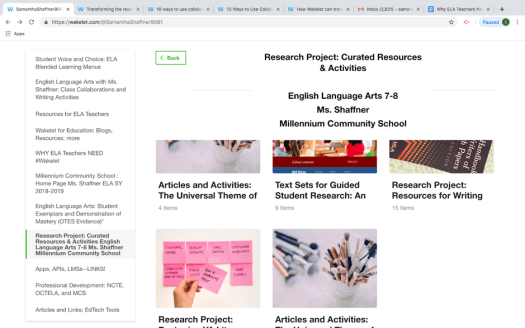Why ELA teachers need Wakelet: Resource bank
Looking to make the most of Wakelet in your classroom? In the first of a series of blogs, Wakelet superhuman Samantha J. Shaffner explains why ELA teachers need Wakelet
What do English Language Arts (ELA) teachers need to succeed? A room, desks, a chalkboard and some writing tablets used to be sufficient, but education has evolved. Adding a projector, pull-down screen, laptops and a whiteboard not only changes the way teachers interact with their students; they also transform the entire learning environment to suit the modern digital world.
In a blended learning classroom, ELA teachers are empowered to find ways to bring the world into our classrooms. Digital learning tools allow teachers to provide a deeper and more rigorous way to share their curriculum with students. The blended learning environment aims to allow students to learn at their own pace, as well as make use of the massive amount of resources online.
Content curation on Wakelet can provide teachers and students with standards-aligned learning activities that lend themselves to the idea that modern curricula should be, in some way, personalized to meet the needs of all learners.
In short, it is our role as ELA teachers to guide and model to students the practice of curation and the responsible use of the Internet and media resources. It is also our job to seek training in various technologies, integrate them into our lessons and activities, and still find time to work one-on-one with students and provide them with meaningful feedback. As we guide them through this process, teachers and students work together to create learning communities that nurture collaboration, critical thinking, confidence, creativity, and communication.
Wakelet is exciting for teachers and students because it merges the worlds of professional social media and EdTech. Wakelet can act as a hub of sorts for ELA teachers and students to express themselves in a close and vetted system. We no longer need to travel from platform to platform to access research materials, or even individual student assignments, because Wakelet lets us combine those apps and their features easily by acting as an electronic whiteboard of sorts. It also serves as a means for teachers to share ideas, student work, and learning experiences through online professional learning networks.
Wakelet as a resource bank for ELA teachers
It shouldn’t be surprising that Wakelet’s primary function is also its most useful in the classroom. Wakelet lets teachers and students save and organize information from across the web in one place. I like thinking of my Wakelet collections as a sort of ‘electronic backpack’ that students and teachers can use to house materials discussed and taught in the classroom, including student writing exemplars. As I bring Wakelet’s features into my classroom more and more, students will be able to look back at their previous work and appreciate their growth as readers, writers, and critical thinkers.
Effective time management and discernment regarding relevant and credible sources is maximized by using Wakelet as a container, organizer, and disseminator of an ELA teacher’s curricula. This is vital because it provides support, while also enhancing learner agency through scaffolding and other best practices in modern day research. It’s just one of the many ways that Wakelet can be used, serving as a home for ELA teachers’ resources and other documents including student work and exemplars of best practices.
You can simplify this process by using Wakelet to streamline and integrate these vital components into our lessons on a daily basis. Other curation platforms exist of course, but as an ELA teacher, my top pick is Wakelet. I believe it has the potential to transform modern ELA classrooms into innovative learning spaces that thoughtfully integrate digital tools into interactive curricula, which is organized, accessible, and orchestrated to meet learning targets in ELA and other subjects.
As a cloud-native platform, Wakelet is always evolving, just like the teaching environment. The team recently added a browser extension that lets users seamlessly add open browser tabs into one collection. Whenever I find an article, tweet or video that I want to include in a lesson plan, the extension makes it incredibly easy to save them all in one place. Then, it’s easy to add notes and instructions to turn the collection into a learning activity or collection of resources for later integration into my ELA curriculum.

In the image above, a variety of resources I curated for my students’ research project unit are kept in a collection for students to access, review, and discuss in class. By allowing you to save many different media types in one place, Wakelet lets you intertwine resources into your activities without students needing to waste time going from site to site.
To learn more about transforming the research process in your ELA classroom, check out my blog ‘Transforming the research process for 21st century learners’ to learn more!

Samantha J. Shaffner is a secondary English Language Arts Teacher at Millennium Community School in, Columbus, OH. This is Samantha’s 12th year in the ELA classroom within an urban charter school setting, where she has also held a variety of administrative positions including director of blended learning and district testing coordinator.
Samantha has a passion for blended learning program/assessment design and implementation of best practices within the field of ELA education, and is an active/contributing member of both the National Council of Teachers of English (NCTE) as well as the Ohio Council for Teachers of English Language Arts (OCTELA).
Samantha enjoys writing and conducting research about cutting edge EdTech tools and applications, as well as serving as a Wakelet Ambassador.
Wakelet profile: @SamanthaShaffner9061,
Twitter: @SamanthaShaffn2
LinkedIn: Samantha J. Shaffner

